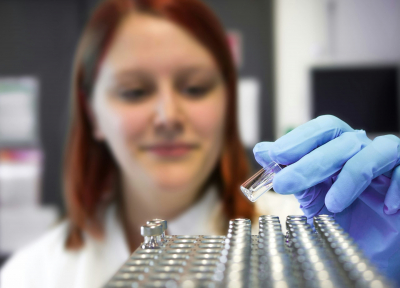HIV & AIDS
Learn about Human Immunodeficiency Virus and how it causes Acquired Immune Deficiency Syndrome.
On This Page:
Overview
Human immunodeficiency virus (HIV) is the cause of acquired immune deficiency syndrome (AIDS). HIV infects and destroys immune cells called CD4 T cells or T helper cells. Overtime the number of your immune cells will decrease as they are killed by the virus, which leads to AIDS. AIDS is when your immune system is significantly weakened by the virus, and you start to experience complications of a weakened immune system. Today, HIV treatment is highly effective at preventing HIV infection from progressing to AIDS and allowing people living with HIV to lead long lives.
Key Points
- Human immunodeficiency virus (HIV) infects T helper cells, immune cells that are part of adaptive immunity.
- Acquired immune deficiency syndrome (AIDS) is caused by HIV severely weakening your immune system.
- There is no cure for HIV infection, but treatments are very effective at preventing the development of AIDS and the further spread of the virus.
Key Statistics
Globally: In 2024, 40.8 million people worldwide were living with HIV and 1.3 million new people became infected with the virus.
US incidence: In 2024, 1.2 million people in the US were living with HIV and 31,800 new people became infected with the virus.
Since the beginning of the HIV epidemic in 1981, 91.4 million people have been infected with the virus and 44.1 million have died from HIV-related causes.
HIV and the Immune System
Human immunodeficiency virus (HIV) is a virus that infects and destroys immune cells. HIV spreads through contact with bodily fluids including blood, semen, vaginal fluids, and breastmilk. This means HIV can spread through activities such as unprotected sex, sharing needles or syringes, or from mother to baby.
Once HIV enters the body, it infects T helper cells (also known as CD4 T cells). When HIV enters a T helper cell, it permanently inserts its viral DNA into the cell’s DNA. The virus has now hijacked the T helper cell, using it to make more copies of the virus. The viral DNA from HIV also becomes permanently part of an infected T helper cell’s DNA. This makes it very difficult for the immune system to find and kill the virus. Because of HIV’s ability to quickly hide within your cells and because it mutates very often, developing a vaccine to prevent HIV is very challenging.
The first stage of HIV infection is called acute HIV. This is when someone is first infected with HIV and may experience mild flu-like symptoms or no symptoms at all. This can then progress to chronic infection where HIV will continue to replicate inside T helper cells, slowly killing them and infecting more cells. At this stage, it’s likely that the infected person won’t experience any noticeable symptoms. During this time, they can still transmit HIV, even if they don’t realize they have it.
HIV infection can affect anyone. To learn more or be tested for the virus, talk to a doctor or visit a local health clinic.
Acquired Immune Deficiency Syndrome
The final stage of HIV infection is acquired immune deficiency syndrome (AIDS). This is when the number of T helper cells becomes very low. This happens years after initial infection and the immune system has been severely weakened by the virus. The T helper cells that HIV infects and destroys are crucial for activating other immune cells to coordinate an immune response. As the number of T helper cells decreases, the immune system becomes weaker, unable to fight off simple infections or prevent the development of cancer.
A person with AIDS is more likely to get opportunistic infections, which are infections a healthy immune system could normally prevent. They are also more likely to develop certain types of cancer. These infections and cancers are called AIDS-defining illnesses. They occur because the T helper cells that are supposed to help initiate immune responses are too weak to respond. Some examples include Kaposi sarcoma, tuberculosis, or chronic herpes ulcers.
HIV treatment and prevention have come a long way, but there is no cure. Today, HIV treatment can prevent HIV infection from progressing to AIDS. When taking HIV treatment as prescribed, many people live long lives. Treatment can even reduce HIV to undetectable levels in person, meaning there is so little virus active in your blood that a test cannot detect it. This doesn’t mean you are cured, but it does mean your treatment is working very effectively. Researchers have even determined that when HIV levels are undetectable and stay undetectable, the virus cannot be transmitted. Immunology research over the last 40 years contributed to these major advancements in HIV treatment that allow people to live decades with little to no symptoms of HIV infection.
Immunology Research and a Cure for HIV
Immunology research is continuing to advance HIV treatments and even help find a cure for the infection. Immunotherapy, treatment that enhances the immune system’s ability to fight disease, is providing promise for people with HIV. A study in 2022, found that a cancer immunotherapy, pembrolizumab, can reverse HIV’s ability to hide in immune cells. The virus’s ability to hide is a major barrier to curing HIV, and immunotherapies like this may be a key step in reaching a cure.
mRNA vaccines are also showing incredible promise in curing HIV. One study found that mRNA can be delivered to the cells where HIV is hiding and provide instructions to the cell that reveal the virus. Being able to reveal the virus and prevent it from hiding can lead to drugs that permanently eliminate HIV from the body. Another study using mRNA vaccines, successfully trained the immune system to recognize and fight HIV, a major battle in developing successful HIV vaccines. With continued advances in immunology and personalized medicine, researchers hope new technology like mRNA vaccines and immunotherpay will finally lead to a cure for HIV.
Sources
- HIV Global Situation and Trends, World Health Organization
Study finds cancer immunotherapy treatment can reverse HIV latency, Doherty Institute
Efficient mRNA delivery to resting T cells to reverse HIV latency, Nature Communications
Two HIV vaccine trials show proof of concept for pathway to broadly neutralizing antibodies, IAVI
Related Topics
Downloads
External Resources
Latest News


